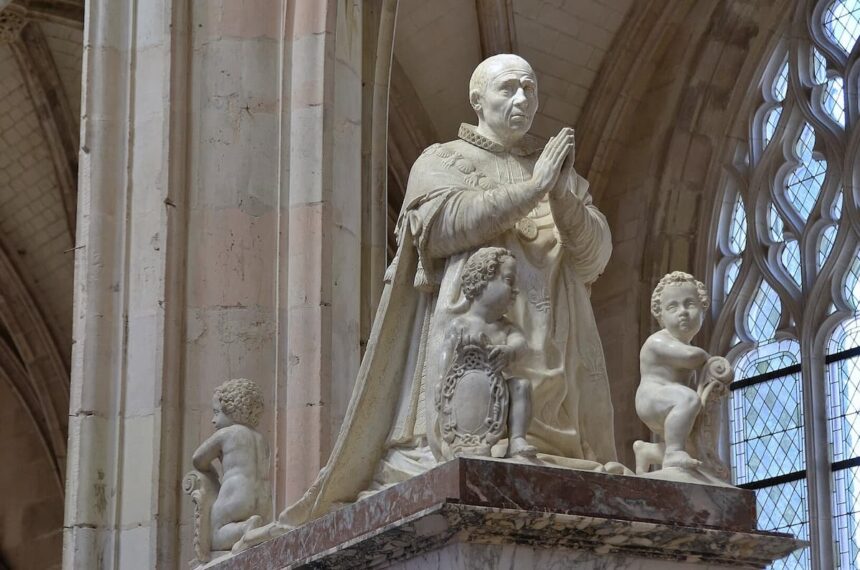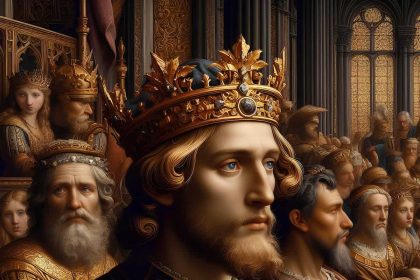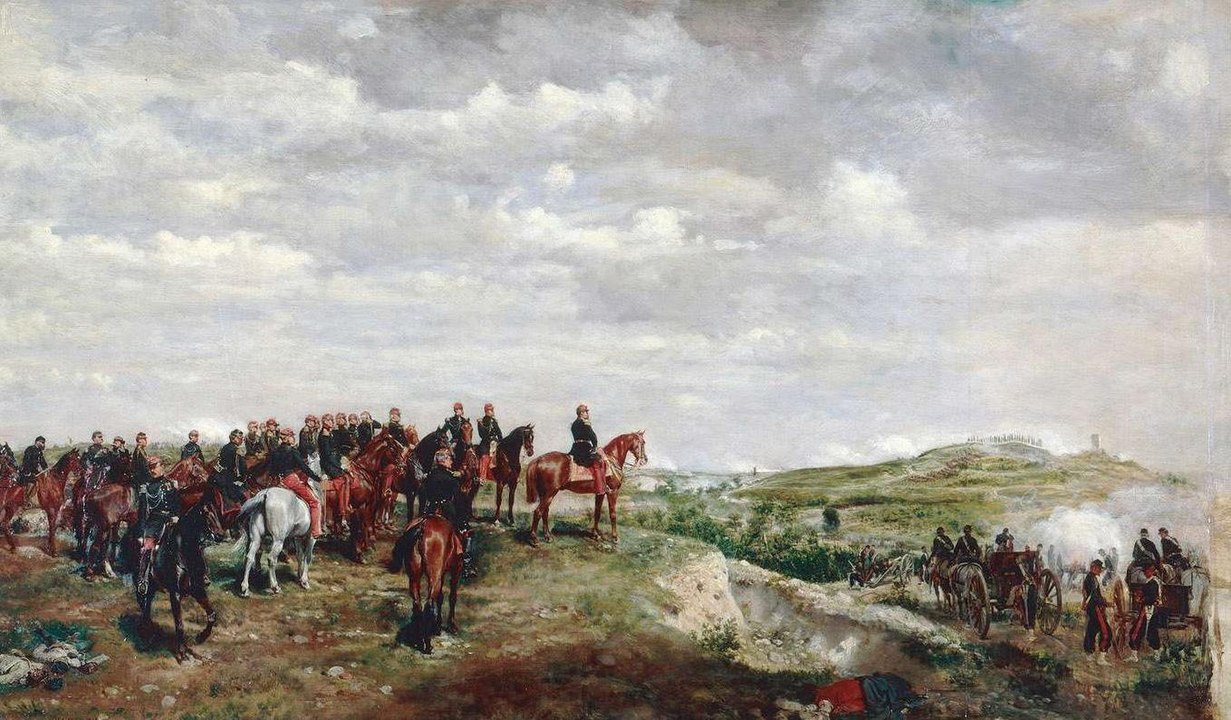King of France from 1461 to 1483, Louis XI, nicknamed “the universal spider,” had the heavy responsibility of restoring France’s prosperity, which had been lost during the Hundred Years’ War. A turbulent son of Charles VII, he earned a reputation as a harsh ruler, sometimes considered a tyrant. Nonetheless, his reign was crucial, not only because of his mortal struggle against Charles the Bold, Duke of Burgundy, but also due to the increasing centralization of power around the king. As France experienced renewed economic growth, Louis XI’s authoritarian reign paved the way for the Renaissance kings and, with them, France’s emergence as the leading European power.
Louis XI: The Turbulent Son of Charles VII
Born in 1423, at a time when France was in a dire position against the English (the Treaty of Troyes was signed in 1420), Louis was the son of Charles VII (not yet king) and Marie of Anjou. He received a high-quality education, particularly in law and theology. However, after becoming Dauphin, he was also a political tool for his father, who married him in 1436 to Margaret of Scotland, who apparently retained a very poor memory of him (she died at just 21).
As Charles VII entrusted him with increasingly important responsibilities, Louis asserted his independence. Along with Jean II of Alençon, he joined the revolt known as the Praguerie at just sixteen years old! This revolt by the princes was crushed by Charles VII, who sent his son to Dauphiné. There, Louis managed his principality autonomously, establishing a parliament in Grenoble in 1451 and marrying Charlotte of Savoy against his father’s wishes. Throughout the 1440s, Louis continually opposed his father, both directly and indirectly, while also building a solid network of supporters.
By 1456, Charles VII directly threatened Dauphiné, and Louis took refuge at the court of Duke Philip the Good of Burgundy. He remained in the Netherlands until his father’s death in 1461, returning to France to be crowned in Reims.
“The Universal Spider”

Louis XI’s political skill, which would later define his reputation, was not yet fully evident at the start of his reign. In his desire to break with his father’s rule, he alienated many competent officials, driving them into the arms of his enemies. Nevertheless, he began to engage in foreign politics, intervening in the affairs of Aragon. His financial support of John II of Aragon against the Catalonian cities’ revolt allowed him to acquire Roussillon and Cerdagne (although his son Charles VIII would later return them to Aragon to secure his position in Italy). He had to subdue Perpignan in 1463 to achieve this. That same year, Louis XI negotiated with Duke Philip the Good of Burgundy to purchase the cities along the Somme, thereby contributing to France’s territorial expansion.
To control a nation increasingly unsettled by the chaos caused by his father’s dismissed officials, Louis XI embarked on a journey to connect with his people, even making symbolic appearances riding a donkey, evoking a direct reference to Christ. These grand journeys became a distinctive feature of his reign.
It was by gradually regaining control of the kingdom that Louis XI earned his famous nickname, “the universal spider,” coined by Philippe de Commynes (1447-1511). The king wove his web, often plotting, while slowly becoming paranoid. This reassertion of control was slow and challenging, involving not only intrigue but also warfare.
The War of the Public Weal
Louis XI’s authoritarian policies and the kingdom’s disarray in the early 1460s encouraged the great lords to rebel against the king. Nearly all of them were involved, including the Count of Charolais (Charles, son of the Duke of Burgundy, and the future “Charles the Bold”) and, most notably, Louis XI’s brother, Charles of France. The rebellious princes gained the support of the Duke of Brittany, claiming to act “for the public good” by proposing reforms to restore the kingdom’s stability, which had been undermined by the king’s policies.
The Battle of Montlhéry (July 16, 1465) did not resolve the situation, and Louis XI began to cultivate a reputation as a skilled negotiator.
Through targeted concessions (some of which he did not always honor, such as when he seized Normandy), he managed to divide the coalition. He was also supported by the cities.
However, the war led by the League of the Public Weal gradually shifted toward a direct confrontation with Burgundy when Charles, Count of Charolais, succeeded his father Philip the Good as Duke of Burgundy. By 1467, the ten-year conflict between Louis XI and Charles the Bold had begun.
Louis XI Against Charles the Bold
The King and the Duke of Burgundy met in 1468 in Péronne. At the same time, Louis XI encouraged the revolt of the Liégeois against Charles. However, it failed, and Louis had to retreat and negotiate, though he still managed to gain the support of Philippe de Commynes. The Duke of Burgundy, on the other hand, benefited from the backing of Edward IV of England through marriage to his daughter. Thus, Louis XI appeared relatively weaker compared to his rival.
However, the 1470s turned in favor of the King of France, despite some early successes by Charles the Bold at the onset of renewed conflict. The Duke of Burgundy was defeated in 1472 at Beauvais, and he then temporarily shifted his ambitions away from France, focusing on the Empire. This only earned him new enemies, including the cities of Alsace, supported by the Swiss. In his attempt to regain control, Charles the Bold eventually failed before the walls of Nancy, where he was found dead in January 1477.
Thus, Louis XI was rid of a formidable adversary, and he was long suspected of having orchestrated the Alsatian revolts, although his role is now considered less significant. However, he faced greater challenges in seizing the possessions of the Duke of Burgundy. The Duke’s daughter, Marie of Burgundy, married Maximilian of Habsburg, and the conflict did not conclude until the Treaty of Arras in 1482. While Louis XI gained Picardy, the Duchy of Burgundy, and Franche-Comté, the Netherlands passed to Philip the Handsome. This had significant consequences, as Philip was the father of Charles V, who would later claim Burgundy during his conflict with Francis I.
Louis XI Beheads the Nobles
Both literally and figuratively, Louis XI took advantage of his power in the 1470s to eliminate some of his remaining rivals. The death of his brother Charles of France confirmed the succession for Louis’ son, born in 1470. Jean d’Armagnac was assassinated in 1473, while the Constable of Saint-Pol and Jacques d’Armagnac were executed in 1475 and 1477, respectively. A conspiracy involving Burgundy, Brittany, and England erupted in 1475, but failed to gain support among the cautious French nobility. The king even secured peace with England through the Treaty of Picquigny (August 29, 1475).
The last obstacle to Louis XI’s dominance over the kingdom was the powerful René of Anjou, his cousin. However, once again, fate favored the French king when René died in 1480, followed shortly by his son. Thus, all Anjou’s possessions reverted to the French crown! Louis XI’s son, Charles VIII, would use this to claim the Kingdom of Naples in 1494, marking the beginning of the Italian Wars.
A Wise Administrator
Throughout his reign, Louis XI focused on promoting France’s economic development and revitalizing agriculture in regions still suffering from the effects of the Hundred Years’ War. He granted tax exemptions, direct subsidies, and invited populations from Spain and Italy to stimulate the cultivation of abandoned lands.
Relying on the urban bourgeoisie — to whom he granted many privileges, fostering industrial and commercial expansion — Louis XI encouraged luxury industries (notably by establishing silk workshops in Lyon and Tours), regulated the cloth and mining industries, expanded printing, and developed major fairs (such as the one in Lyon, surpassing its rival in Geneva). He also improved the road network, waterways, and ports.
In the military realm, Louis XI continued his father’s work, increasing the number of ordinance companies and free-archer corps, while also instituting a mounted courier service, a precursor to a genuine postal system (1464). The return of prosperity allowed him to levy heavy taxes, which made him increasingly unpopular.
While Louis XI is not usually associated with the arts, he was nonetheless a shrewd and sometimes tyrannical political figure. Though often seen as lacking the refinement of Italian patrons or even Charles V (1364-1380), recent scholarship suggests that Louis XI did take an interest in the arts, albeit for political reasons rather than personal taste.
Louis XI and Art as a Political Tool
Louis XI had a reputation for sobriety and simplicity, often avoiding ostentation and luxury, which is reflected in most portrayals of him. This extended to his court and residences, making him stand apart from contemporaries like Borso d’Este, Lorenzo the Magnificent, and Federico da Montefeltro, as well as his rivals, the Dukes of Burgundy, who were great patrons of the arts and lovers of opulence.
Despite this, Louis XI’s court was not devoid of grandeur, with over 200 individuals reportedly present at the Hôtel du Roi. The King, always mindful of expenses, nonetheless possessed significant wealth (France was the richest monarchy in the West at the time), and he did not hesitate to display it during official receptions for foreign dignitaries, ambassadors, or sovereigns. For instance, during the reception of the Earl of Warwick in 1468 and the Queen of England three years later, elaborate ceremonies were organized.
Louis XI also used the arts as a tool against his enemies. For example, after the death of Charles the Bold in 1477, the king ordered the removal of the Duke’s arms and their replacement with his own. He even resorted to defamatory paintings, such as one depicting the Prince of Orange hanging upside down, which was displayed in Dijon in 1477. He promoted pamphlets against the English and the Burgundians and used jesters in public squares to spread positive messages about himself.
Much like the Italians of that time, and foreshadowing the early modern period, Louis XI understood the importance of maintaining a visible image of his person throughout the kingdom. He became one of the most frequently depicted French kings through statues, stained glass, paintings, and medals, such as those created by Francesco Laurana. These depictions particularly emphasized recently acquired territories, such as Anjou after the death of King René.
Louis XI and Artists
Louis XI’s approach to the arts influenced his patronage and choice of artists. He followed the tradition of his predecessors, such as his father Charles VII, by bringing Jean Fouquet to his court. Following the example of René of Anjou, he surrounded himself with renowned artists like musician Jean Ockeghem and painters Colin d’Amiens and Coppin Delf. Louis XI attracted both national artists, like Fouquet and Bourdichon, and foreigners like Francesco Laurana and Georges Hermonyme. He also stood out by recruiting local artists and craftsmen, even for major works (such as the Notre-Dame de la Salvation in Compiègne in 1468).
His interest in the arts extended beyond painting, architecture, and goldsmithing; he also supported humanist literature, engaging figures like François Filelfe, Robert Gaguin, and Francesco Gaddi.
Louis XI rigorously managed the recruitment of his artists, testing them, creating competition, and assigning them different ranks. For example, Jean Galant was appointed royal goldsmith, Jean Fouquet royal painter, and Jean Ockeghem master of the royal chapel choir. These artists were rewarded with both financial compensation and honorary titles. However, Louis XI did not form close relationships with them, though he trusted Ockeghem enough to send him on a diplomatic mission to Spain.
Louis XI’s Artistic Taste
Louis XI had the reputation of being devout, and this was reflected in his artistic preferences. His primary focus was religion, and he made numerous donations to churches, which even his advisor Philippe de Commynes considered excessive. His goldsmithing was mostly religious in nature, such as the arm reliquary of Charlemagne offered to Aachen in 1481. Louis XI expressed his piety through art and patronage, glorifying God, Mary, and various saints, such as Saint Martin of Tours and Saint Michael, after whom he named his chivalric order, established in 1469.
This religious devotion extended to his early desire to have a unique funerary monument, initially commissioned from Fouquet and Michel Colombe in 1471, then later from Colin d’Amiens in 1481 after being disappointed with the initial work. He had specific requirements, including being depicted kneeling rather than recumbent like previous sovereigns. The monument was placed in the Basilica of Notre-Dame de Cléry, where Louis XI refused to be buried at Saint-Denis.
For secular arts, Louis XI favored architecture that reflected his personality. His palaces, like the Château of Plessis (purchased in 1463 and regularly improved), emphasized comfort over luxury. Few of his paintings survive, but it is known that he greatly enjoyed illuminated manuscripts (such as those by Jean Colombe) that adorned his library. He is also recognized as a learned and erudite king, especially interested in political works. Sculpture, tapestry, and music were appreciated by the monarch, though seemingly to a lesser extent, as few traces remain.
While Louis XI did not ignore the arts, he understood their political importance and used them accordingly. The arts he promoted were simple and deeply religious, reflecting his personality. As historian Sophie Cassagnes-Brouquet notes, the king practiced “a tempered and interested patronage with political aims.”
A Difficult End of Reign
Over the course of his reign, Louis XI managed to find a certain balance between authoritarianism and negotiations, particularly with the lower nobility, who, unlike the higher nobility, never really revolted against him. For a time, he benefited from the economic prosperity and population growth observed at the end of Charles VII’s reign, and he initiated reforms that demonstrated a certain unity within the kingdom (such as the creation of the royal postal service in 1477).
However, the early 1480s proved to be more challenging, and Louis XI had to impose a fiscal policy that sparked new tensions, especially with the cities, which had until then been important supporters of the king.
Increasingly devout and had a fragile health condition that had persisted for a long time, Louis XI died on August 30, 1483. Unlike other French monarchs, he was not buried at Saint-Denis but in the Basilica of Notre-Dame de Cléry, where he had commissioned a funerary monument from several prominent artists of his time as early as the late 1460s, showing an appreciation for the arts that historians had long denied him.
His son, Charles VIII, still a minor, succeeded him after the regency of Anne of France and Pierre de Bourbon-Beaujeu. France then fully entered the Renaissance.






